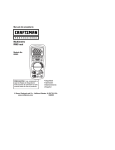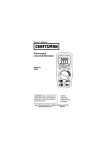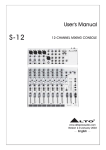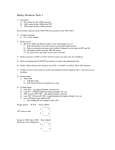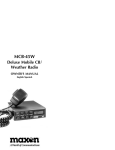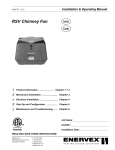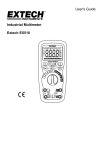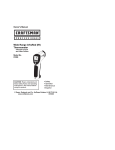Download Craftsman 82003 Owner`s manual
Transcript
Owner's Manual True RMS Multimeter Model No. 82003 CAUTION: Read, understand and follow Safety Rules and Operating Instructions in this manual before using this product. Safety Operation Maintenance Español © Sears, Roebuck and Co., Hoffman Estates, IL 60179 U.S.A. www.craftsman.com 042508 TABLE OF CONTENTS Warranty Safety Instructions Safety Symbols Control and Jacks Symbols and Annunciators Specifications Battery Installation Operating Instructions DC Voltage Measurements AC Voltage Measurements DC Current Measurements AC Current Measurements Resistance Measurements Continuity Check Diode Test Capacitance Measurements Frequency (Duty Cycle) Measurements Temperature Measurements Autoranging/Manual range selection Relative Mode Display Backlight Hold Auto Power Off Low Battery Indication Maintenance Battery Replacement Fuse Replacement Troubleshooting Service and Parts 2 Page 3 4 5 6 6 7 11 12 12 13 14 15 16 17 17 18 18 19 20 20 21 21 21 21 22 23 24 25 25 ONE YEAR FULL WARRANTY CRAFTSMAN PROFESSIONAL ONE YEAR FULL WARRANTY. If this product fails due to a defect in materials or workmanship within one year from the date of purchase, RETURN IT TO ANY SEARS STORE OR OTHER CRAFTSMAN OUTLET IN THE UNITED STATES for free replacement. This warranty gives you specific legal rights, and you may also have other rights which vary from state to state. Sears, Roebuck and Co., Hoffman Estates, IL 60179 For Customer Assistance Call 9am - 5pm (ET) Monday through Friday 1-888-326-1006 WARNING: USE EXTREME CAUTION IN THE USE OF THIS DEVICE. Improper use of this device can result in injury or death. Follow all safeguards suggested in this manual in addition to the normal safety precautions used in working with electrical circuits. DO NOT service this device if you are not qualified to do so. 3 SAFETY INSTRUCTIONS This meter has been designed for safe use, but must be operated with caution. The rules listed below must be carefully followed for safe operation. 1. NEVER apply voltage or current to the meter that exceeds the specified maximum: Input Limits Function V DC or V AC mA AC/DC A AC/DC Maximum Input 1000VDC/AC rms 400mA AC/DC 10A AC/DC (20A for 30 seconds max every 15 minutes) Resistance, Diode Test, Continuity, Capacitance, Frequency, Temperature 1000VDC/AC rms 2. USE EXTREME CAUTION when working with high voltages 3. DO NOT measure voltage if the voltage on the "COM" input jack exceeds 1000V above earth ground 4. DO NOT measure current of circuits whose voltage is greater than 600V above earth ground 5. NEVER connect the meter leads across a voltage source while the function switch is in the resistance or diode mode. Doing so can damage the meter ALWAYS turn off the power and disconnect the test leads before opening the cover to replace the fuse or battery 6. 7. NEVER operate the meter unless the back cover is in place and fastened securely 4 SAFETY SYMBOLS This symbol adjacent to another symbol, terminal or operating device indicates that the operator must refer to an explanation in the Operating Instructions to avoid personal injury or damage to the meter. WARNING This WARNING symbol indicates a potentially hazardous situation, which if not avoided, could result in death or serious injury. CAUTION This CAUTION symbol indicates a potentially hazardous situation, which if not avoided, may result damage to the product. MAX 1000V This symbol advises the user that the terminal(s) so marked must not be connected to a circuit point at which the voltage with respect to earth ground exceeds (in this case) 1000 VAC or VDC. This symbol adjacent to one or more terminals identifies them as being associated with ranges that may, in normal use, be subjected to particularly hazardous voltages. For maximum safety, the meter and its test leads should not be handled when these terminals are energized. This symbol indicates that a device is protected throughout by double insulation or reinforced insulation. 5 CONTROLS AND JACKS 1. 2. 3. 4. 5. 6. 7. 8. 9. 10. 11. 4,000 count LCD display RANGE button Hz and % button Mode button Function switch mA, µA and 10A input jacks COM input jack Positive input jack Backlight button REL button HOLD button Note: Tilt stand and battery compartment are on rear of unit. SYMBOLS AND ANNUNCIATORS •))) n µ m A k F M Hz % AC DC ºF Continuity Diode test Battery status -9 nano (10 ) (capacitance) -6 micro (10 ) (amps) -3 milli (10 ) (volts, amps) Amps 3 kilo (10 ) (ohms) Farads (capacitance) 6 mega (10 ) (ohms) Ohms Hertz (frequency) Percent (duty ratio) Alternating current Direct current Degrees Fahrenheit 6 V REL Auto HOLD ºC Volts Relative Autoranging Display hold Degrees Centigrade SPECIFICATIONS Function Range DC Voltage 400mV Resolution 0.1mV 4V 40V 400V 1000V 0.001V 0.01V 0.1V 1V AC Voltage 400mV 0.1mV 4V 40V 400V 1000V 0.001V 0.01V 0.1V 1V DC Current 400A 4000A 40mA 400mA 10A AC Current 400A 4000A 40mA 400mA 10A Accuracy (0.5% reading + 2 digits) (1.2% reading + 2 digits) (1.5% reading + 2 digits) (2.0% reading + 10 digits) (2.0% reading + 5 digits) (2.5% reading + 5 digits) (1.0% reading + 3 digits) 0.1A 1A 0.01mA 0.1mA 0.01A (1.5% reading + 3 digits) (2.5% reading + 5 digits) (2.5% reading + 10 digits) 0.1A 1A 0.01mA 0.1mA 0.01A (2.5% reading + 5 digits) (3.0% reading + 7 digits) 0.1 (1.2% reading + 4 digits) 4k 0.001k (1.0% reading + 2 digits) 40k 0.01k 400k 0.1k 4M 0.001M 40M 0.01M Resistance 400 (1.2% reading + 2 digits) 7 (2.0% reading + 3 digits) Function Range Capacitance 40nF 400nF Frequency Duty Cycle Temp (type-K) Resolution 0.01nF Accuracy (5.0% reading + 7 digits) 0.1nF 4F 0.001F 40F 0.01F (3.0% reading + 5 digits) 100F 0.1F 5.999Hz 0.001Hz 59.99Hz 0.01Hz 599.9Hz 0.1Hz 5.999kHz 0.001kHz 59.99kHz 0.01kHz 599.9kHz 0.1kHz 5.999MHz 0.001MHz 9.999MHz 0.001MHz Sensitivity: 0.5V rms <500kHz; 0.1 to 99.9% 0.1% (5% reading + 5 digits) (1.5% reading + 1 digits) (1.2% reading + 3 digits) (1.5% reading + 4 digits) 3V rms >500kHz (1.2% reading + 2 digits) Pulse width: 100µs - 100ms, Frequency: 5Hz to 150kHz -4 to 1382F 0.1<400 (3.0% reading + 5C /9F ) (probe accuracy not included) -20 to 750C 1 ≥ 400 Supplied Probe range: -58.0 to 482oF (-50.0 to 250oC) Note: An optional probe that is rated to the full range of the meter is available from the www.craftsman.com website. o o o o Note: Accuracy is stated at 65 F to 83 F (18 C to 28 C) and less than 75% RH. Note: Accuracy specifications consist of two elements: (% reading) – This is the accuracy of the measurement circuit. (+ digits) – This is the accuracy of the analog to digital converter. 8 Enclosure Shock (Drop Test) Diode Test Double molded, waterproof (IP67) 6.5 feet (2 meters) Test current of 0.3mA typical, open circuit voltage 1.5V DC typical Continuity Check Audible signal will sound if the resistance is less than 100 (approx.), test current <0.3mA Temperature Sensor Requires type K thermocouple Input Impedance 7.8MΩ AC Response True rms ACV Bandwidth 50Hz to 400Hz Crest Factor ≤3 at full scale up to 500V, decreasing linearly to ≤1.5 at 1000V Display 4,000 count backlit liquid crystal Overrange indication “OL” is displayed Auto Power Off 30 minutes (approximately) Polarity Automatic (no indication for positive); Minus (-) sign for negative Measurement Rate 2 times per second, nominal Low Battery Indication “ ” is displayed if battery voltage drops below operating voltage Battery One 9 volt (NEDA 1604) battery Fuses mA, µA ranges; 0.5A/1000V ceramic fast blow A range; 10A/1000V ceramic fast blow Operating Temperature 41F to 104F (5C to 40C) Storage Temperature -4F to 140F (-20C to 60C) Operating Humidity Max 80% up to 87F (31C) decreasing linearly to 50% at 104F (40C) Storage Humidity <80% Operating Altitude 7000ft. (2000meters) maximum. Weight 0.908lb (412g) (includes holster). Size 7.2” x 3.2” x 2.2” (182 x 82 x 55mm) 9 Safety Approvals UL Listed This meter is intended for origin of installation use and protected, against the users, by double nd insulation per EN61010-1 and IEC61010-1 2 Edition (2001) to Category IV 600V and Category III 1000V; Pollution Degree 2. The meter also meets nd UL 61010-1, 2 Edition (2004), CAN/CSA C22.2 nd No. 61010-1 2 Edition (2004), and UL 61010B-2st 031, 1 Edition (2003) UL CE The UL mark does not indicate that this product has been evaluated for the accuracy of its readings. 10 BATTERY INSTALLATION WARNING: To avoid electric shock, disconnect the test leads from any source of voltage before removing the battery cover. 1. Turn power off and disconnect the test leads from the meter. 2. Open the rear battery cover by removing two screws (B) using a Phillips head screwdriver. 3. Insert the battery into battery holder, observing the correct polarity. 4. Put the battery cover back in place. Secure with the screws. WARNING: To avoid electric shock, do not operate the meter until the battery cover is in place and fastened securely. NOTE: If your meter does not work properly, check the fuses and batteries to make sure that they are still good and that they are properly inserted. A B A B F1 F2 11 A OPERATING INSTRUCTIONS WARNING: Risk of electrocution. High-voltage circuits, both AC and DC, are very dangerous and should be measured with great care. 1. ALWAYS turn the function switch to the OFF position when the meter is not in use. 2. If “OL” appears in the display during a measurement, the value exceeds the range you have selected. Change to a higher range. NOTE: On some low AC and DC voltage ranges, with the test leads not connected to a device, the display may show a random, changing reading. This is normal and is caused by the high-input sensitivity. The reading will stabilize and give a proper measurement when connected to a circuit. DC VOLTAGE MEASUREMENTS CAUTION: Do not measure DC voltages if a motor on the circuit is being switched ON or OFF. Large voltage surges may occur that can damage the meter. 1. Set the function switch to the V position. 2. Press the MODE button to select DC (if necessary). 3. Insert the black test lead banana plug into the negative COM jack. Insert the red test lead banana plug into the positive V jack. 4. Touch the black test probe tip to the negative side of the circuit. Touch the red test probe tip to the positive side of the circuit. 5. Read the voltage in the display. 12 AC VOLTAGE (Frequency, Duty Cycle) MEASUREMENTS AC VOLTAGE: The probe tips may not be long enough to contact the live parts inside some 240V outlets for appliances because the contacts are recessed deep in the outlets. As a result, the reading may show 0 volts when the outlet actually has voltage on it. WARNING: To avoid electric shock, make sure the probe tips are touching the metal contacts inside the outlet before assuming no voltage is present CAUTION: Do not measure AC voltages if a motor on the circuit is being switched ON or OFF. Large voltage surges may occur that can damage the meter. 1. Set the function switch to the V position. 2. Press the MODE button to select AC (if necessary) 3. Insert the black test lead banana plug into the negative COM jack. Insert red test lead banana plug into the positive V jack. 4. Touch the black test probe tip to the neutral side of the circuit. Touch the red test probe tip to the “hot” side of the circuit. 5. Read the voltage in the display. 6. Press the HZ/% button to indicate “Hz”. 7. Read the frequency in the display. 8. Press the Hz/% button again to indicate “%”. 9. Read the % of duty cycle in the display. 13 DC CURRENT MEASUREMENTS CAUTION: Do not make current measurements on the 20A scale for longer than 30 seconds. Exceeding 30 seconds may cause damage to the meter and/or the test leads. 1. Insert the black test lead banana plug into the negative COM jack. 2. For current measurements up to 4000µA DC, set the function switch to the µA position and insert the red test lead banana plug into the µA/mA jack. 3. For current measurements up to 400mA DC, set the function switch to the mA position and insert the red test lead banana plug into the µA/mA jack. 4. For current measurements up to 10A DC, set the function switch to the 10A position and insert the red test lead banana plug into the 10A jack. 5. Press the MODE button to indicate “DC” on the display. 6. Remove power from the circuit under test, then open up the circuit at the point where you wish to measure current. 7. Touch the black test probe tip to the negative side of the circuit. Touch the red test probe tip to the positive side of the circuit. 8. Apply power to the circuit. 9. Read the current in the display. 14 AC CURRENT (Frequency, Duty Cycle) MEASUREMENTS CAUTION: Do not make current measurements on the 20A scale for longer than 30 seconds. Exceeding 30 seconds may cause damage to the meter and/or the test leads. 1. Insert the black test lead banana plug into the negative COM jack. 2. For current measurements up to 4000µA AC, set the function switch to the µA position and insert the red test lead banana plug into the µA/mA jack. 3. For current measurements up to 400mA AC, set the function switch to the mA position and insert the red test lead banana plug into the µA/mA jack. 4. For current measurements up to 10A AC, set the function switch to the 10A position and insert the red test lead banana plug into the 10A jack. 5. Press the MODE button to indicate “AC” on the display. 6. Remove power from the circuit under test, then open up the circuit at the point where you wish to measure current. 7. Touch the black test probe tip to the neutral side of the circuit. Touch the red test probe tip to the “hot” side of the circuit. 8. Apply power to the circuit. 9. Read the current in the display. 10. Press the Hz/% button to indicate “Hz”. 11. Read the frequency in the display. 12. Press the Hz/% button again to indicate “%”. 13. Read the % duty cycle in the display. 14. Press the Hz/% button to return to current measurement. 15 RESISTANCE MEASUREMENTS WARNING: To avoid electric shock, disconnect power to the unit under test and discharge all capacitors before taking any resistance measurements. Remove the batteries and unplug the line cords. 1. Set the function switch to the ΩCAP position. 2. Insert the black test lead banana plug into the negative COM jack. Insert the red test lead banana plug into the positive jack. 3. Press the MODE button to indicate “"on the display. 4. Touch the test probe tips across the circuit or part under test. It is best to disconnect one side of the part under test so the rest of the circuit will not interfere with the resistance reading. 5. Read the resistance in the display. 16 CONTINUITY CHECK WARNING: To avoid electric shock, never measure continuity on circuits or wires that have voltage on them. 1. Set the function switch to the Ω CAP position. 2. Insert the black lead banana plug into the negative COM jack. Insert the red test lead banana plug into the positive jack. 3. Press the MODE button to indicate” "and “Ω” on the display 4. Touch the test probe tips to the circuit or wire you wish to check. 5. If the resistance is less than approximately 100, the audible signal will sound. If the circuit is open, the display will indicate “OL”. DIODE TEST 1. Set the function switch to the Ω CAP position. 2. Insert the black test lead banana plug into the negative COM jack and the red test lead banana plug into the positive V jack. 3. Press the MODE button to indicate and V on the display. 4. Touch the test probes to the diode under test. Forward voltage will typically indicate 0.400 to 0.700V. Reverse voltage will indicate “OL”. Shorted devices will indicate near 0V and an open device will indicate “OL” in both polarities. 17 CAPACITANCE MEASUREMENTS WARNING: To avoid electric shock, disconnect power to the unit under test and discharge all capacitors before taking any capacitance measurements. Remove the batteries and unplug the line cords. 1. Set the rotary function switch to the Ω CAP position. 2. Insert the black test lead banana plug into the negative COM jack. Insert the red test lead banana plug into the positive V jack. 3. Press the MODE button to indicate “nF” on the display. 4. Touch the test leads to the capacitor to be tested. 5. The test may take up to 3 minutes or more for large capacitors to charge. Wait until the readings settle before ending the test. 6. Read the capacitance value in the display FREQUENCY (Duty Cycle) MEASUREMENTS (Electronic) 1. Set the rotary function switch to the “Hz %” position. 2. Press the Hz/% button to indicate “Hz” in the display. 3. Insert the black lead banana plug into the negative COM jack and the red test lead banana plug into the positive Hz jack. 4. Touch the test probe tips to the circuit under test. 5. Read the frequency on the display. 6. Press the Hz/% button again to indicate “%” on the display. 7. Read the % of duty cycle on the display. 18 TEMPERATURE MEASUREMENTS 1. Set the function switch to the ºF or ºC position. 2. Insert the Temperature Probe into the input jacks, making sure to observe the correct polarity. 3. Touch the Temperature Probe head to the part whose temperature you wish to measure. Keep the probe touching the part under test until the reading stabilizes (about 30 seconds). 4. Read the temperature in the display. Note: The temperature probe is fitted with a type K mini connector. A mini connector to banana connector adaptor is supplied for connection to the input banana jacks. Note: The supplied thermocouple is rated for 482°F (250°C). For higher temperatures you can purchase a high temperature thermocouple from www.craftsman.com. FREQUENCY SENSITIVITY (ELECTRICAL) The frequency sensitivity is range dependent when the function is selected from while in the voltage or current measuring function. Below are typical sensitivities for the “electrical” measurement modes. Range ( DC/AC ) 4V Sensitivity Frequency width ≥1.5V rms 5Hz~10kHz 40V, 400V ≥10V rms 5Hz~20kHz 1000V/1000V ≥20V rms ≥420V rms 5Hz~200kHz 50Hz~1kHz 400mA ≥45mA rms 5Hz~5kHz 10A ≥4A rms 5Hz~1kHz 19 AUTORANGING/MANUAL RANGE SELECTION When the meter is first turned on, it automatically goes into Autoranging. This automatically selects the best range for the measurements being made and is generally the best mode for most measurements. For measurement situations requiring that a range be manually selected, perform the following: 1. Press the RANGE key. The “Auto” display indicator will turn off. 2. Press the RANGE key to step through the available ranges. Observe the decimal point and units displayed until the preferred range is located. 3. To exit the Manual Ranging mode and return to Autoranging, press and hold the RANGE key for 2 seconds. Note: Manual ranging does not apply for the Capacitance and Frequency functions. RELATIVE MODE The relative measurement feature allows you to make measurements relative to a stored zero reference value. A reference voltage, current, etc. can be stored and measurements made in comparison to that value. The displayed value is the difference between the reference value and the measured value. 1. Perform the measurement as described in the operating instructions. 2. Press the REL button to store (zero) the reading in the display and the "REL" indicator will appear on the display. 3. The display will now indicate the difference between the stored value and the measured value. 4. Press the REL button to exit the relative mode. Note: The Relative function does not operate in the Frequency function. DISPLAY BACKLIGHT Press the backlight button to turn on. The light will slowly fade to off after approxamately 10 to 15 seconds. HOLD The hold function freezes the reading in the display. Press the HOLD key momentarily to activate or to exit the HOLD function. 20 AUTO POWER OFF The auto off feature will turn the meter off after 30 minutes. To disable the auto power off feature, hold down the MODE button and turn the meter on. LOW BATTERY INDICATION The icon will appear in the display when the battery voltage becomes low. Replace the battery when this appears. 21 MAINTENANCE WARNING: To avoid electric shock, disconnect the test leads from any source of voltage before removing the back cover or the battery cover. WARNING: To avoid electric shock, do not operate your meter until the battery cover is in place and fastened securely. This multimeter is designed to provide years of dependable service, if the following care instructions are performed: 1. KEEP THE METER DRY. If it gets wet, wipe it off. 2. USE AND STORE THE METER IN NORMAL TEMPERATURES. Temperature extremes can shorten the life of the electronic parts and distort or melt plastic parts. 3. HANDLE THE METER GENTLY AND CAREFULLY. Dropping it can damage the electronic parts or the case. 4. KEEP THE METER CLEAN. Wipe the case occasionally with a damp cloth. DO NOT use chemicals, cleaning solvents, or detergents. 5. USE ONLY FRESH BATTERIES OF THE RECOMMENDED SIZE AND TYPE. Remove old or weak batteries so they do not leak and damage the unit. 6. IF THE METER IS TO BE STORED FOR A LONG PERIOD OF TIME, the batteries should be removed to prevent damage to the unit. UL LISTED The UL mark does not indicate that this product has been evaluated for the accuracy of its readings. 22 BATTERY INSTALLATION WARNING: To avoid electric shock, disconnect the test leads from any source of voltage before removing the battery cover. 1. Turn power off and disconnect the test leads from the meter. 2. Open the rear battery cover by removing two screws (B) using a Phillips head screwdriver. 3. Insert the battery into battery holder, observing the correct polarity. 4. Put the battery cover back in place. Secure with the screws. WARNING: To avoid electric shock, do not operate the meter until the battery cover is in place and fastened securely. NOTE: If your meter does not work properly, check the fuses and batteries to make sure that they are still good and that they are properly inserted. REPLACING THE FUSES WARNING: To avoid electric shock, disconnect the test leads from any source of voltage before removing the fuse cover. 1. Disconnect A A B the test B A leads from the meter. 2. Remove the battery cover (two “B” screws) and F1 F2 the battery. 3. Remove the six “A” screws securing the rear cover. 4. Gently remove the old fuse and install the new fuse into the holder. 23 5. Always use a fuse of the proper size and value (0.5A/1000V fast blow for the 400mA range [SIBA 70-172-40], 10A/1000V fast blow for the 20A range [SIBA 50-199-06]). 6. Replace and secure the rear cover, battery and battery cover. WARNING: To avoid electric shock, do not operate your meter until the fuse cover is in place and fastened securely. 24 TROUBLESHOOTING There may be times when your meter does not operate properly. Here are some common problems that you may have and some easy solutions to them. Meter Does Not Operate: 1. Always read all the instructions in this manual before use. 2. Check to be sure the battery is properly installed. 3. Check to be sure the battery is good. 4. If the battery is good and the meter still doesn’t operate, check to be sure that both ends of the fuse are properly installed. If You Do Not Understand How the Meter Works: Call our Customer Service Line 1-888-326-1006. SERVICE AND PARTS Item Number Description 82378 82003-D 82003-C 82003-CS 82377 Set of black and red Test Leads Replacement battery cover Front cover Rear cover screws Thermocouple probe For replacement parts shipped directly to your home Call 9 am – 5 pm Eastern Time, M - F 1-888-326-1006 25

























